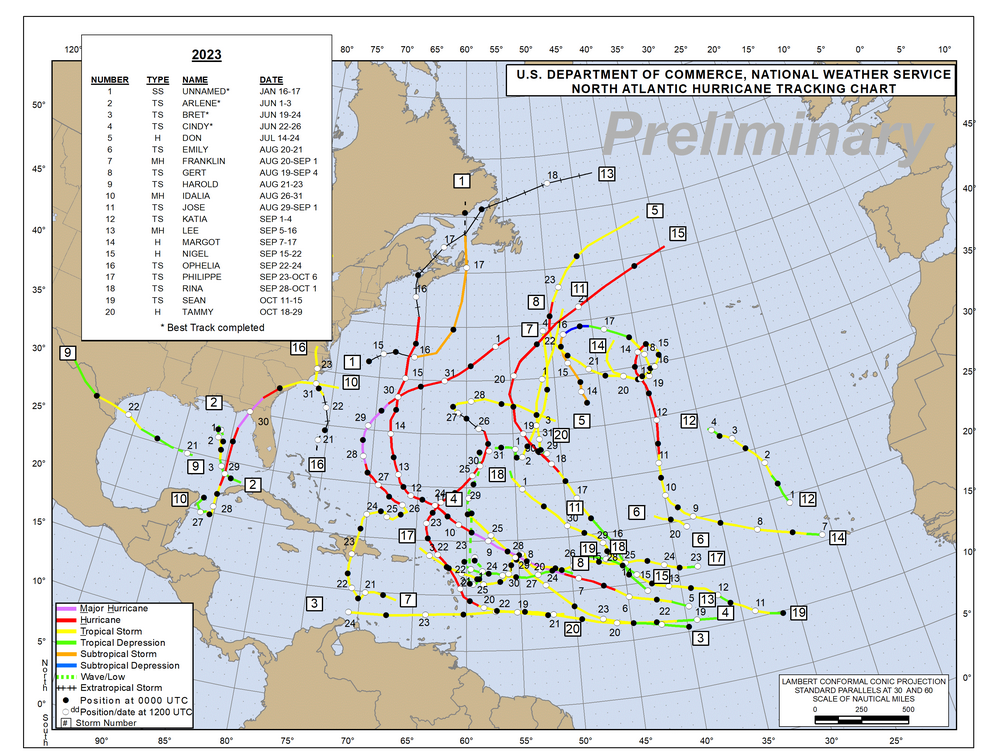THE official end of the Atlantic hurricane season last Thursday, November 30, brought claims that it was the ‘fourth busiest on record’, with lurid accounts of terrible storms. For instance, USA Today‘s headline read ‘Atlantic hurricane season 2023 was filled with monster storms’.
None of this is true.
There were seven hurricanes in all, three of which were Category 3 and over (on a scale of 1-5). Both numbers were spot on the 30-year average. Hurricane frequency this year ranks only 33rd highest since 1851, and there have been 55 other years with the same number or greater.

In other words, it has been a perfectly normal year.
The claim of ‘fourth busiest’ stems from the number of ‘named storms’. As well as hurricanes, these include the much weaker tropical storms, which can have average wind speeds of as little as 39mph, much less powerful than many of the winter storms which head our way across the Atlantic. When we look at trends in these tropical storms, we see that they have doubled in number since the 1990s:

https://www.aoml.noaa.gov/hrd/hurdat/comparison_table.html
But this does not mean that more storms are forming. In a remarkable lapse in its editorial standards (!), the BBC explained all this a couple of years ago:
‘Over the past 10 to 15 years, though, named storms have formed prior to the official start about 50 per cent of the time. And the way they are defined and observed has changed significantly over time. “Many of these storms are short-lived systems that are now being identified because of better monitoring and policy changes that now name sub-tropical storms,” Dennis Feltgen, meteorologist at the US National Hurricane Center (NHC) told BBC Weather. The number of named storms has increased over the decades, but there is no real evidence this is the result of a warming world.’
In fact there was a step change in policy in 2002, when the US National Hurricane Center began naming all sub-tropical storms. Previously these were given only a number.
Before the satellite era, of course, most of the storms now named would not even have been spotted in the middle of the ocean.
In short, we now name more storms than before 2002, but there is no evidence that more storms are actually occurring. And when they tell you it was the fourth busiest season on record, they actually mean the fourth busiest since 2002!
(I should point out that the named storms do not include the storms which the Met Office gives silly names to – these are known as extratropical storms.)
. . . or more powerful
MANY people believe that hurricanes are either becoming more frequent, more powerful, or both, because the media tell them so. The BBC, for example, still broadcast a video produced in 2022 on their weather page, which wrongly claimed hurricanes are getting stronger.
The real world data shows there is no basis for any of these claims.
The best long-term record we have is for hurricanes which have made landfall in the US. The US Hurricane Research Division have records dating back to 1851, and they believe that this database is probably pretty complete since 1900, by which time most of the Atlantic and Gulf coast had been populated.


The data is perfectly clear: there has been no increasing trend in the frequency of either all hurricanes or the stronger ones (Cat 3 and over).
The National Oceanic and Atmospheric Administration (NOAA), the US federal agency who deal with all climate matters, recently confirmed this:
This year there was just one hurricane in the US, well below the 30-year average of 3.8.
Many hurricanes meander around the Atlantic without ever hitting the US, and it is only since full satellite coverage began in the 1980s that we have been able to track them from start to finish. For this reason, long-term comparisons are not only worthless, but highly and deliberately misleading.
You can see the stark difference between the hurricanes/storms which were tracked in 1923 and this year:

https://www.aoml.noaa.gov/hrd/hurdat/track_maps/1923_base.gif

https://www.nhc.noaa.gov/tafb_latest/tws_atl_latest.gif
Apparently they did not have storms in the mid-Atlantic in those days!
Hurricane scientists have, however, put a lot of work into filling in the gaps, re-analysing historical meteorological data. Based on much research, NOAA confirm that: ‘Similarly for Atlantic basin-wide hurricane frequency (after adjusting for changing observing capabilities over time), there is not strong evidence for an increase since the late 1800s in hurricanes, major hurricanes, or the proportion of hurricanes that reach major hurricane intensity.’
I doubt whether you will see that reported by the BBC!











